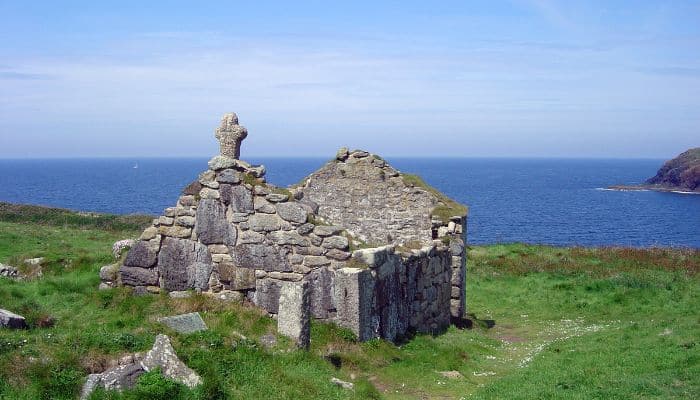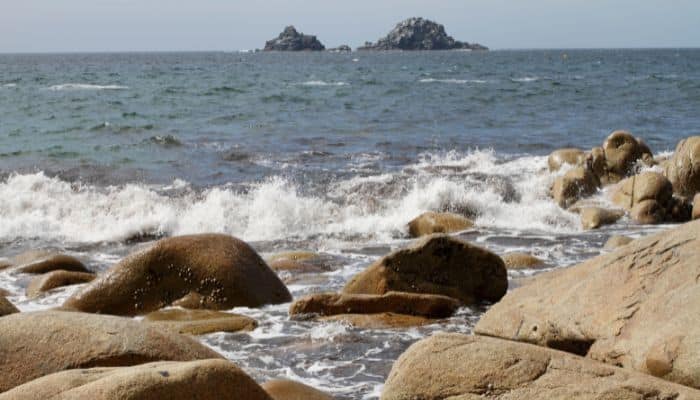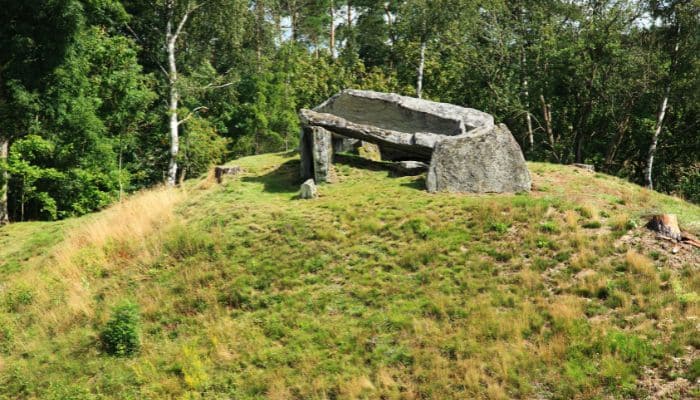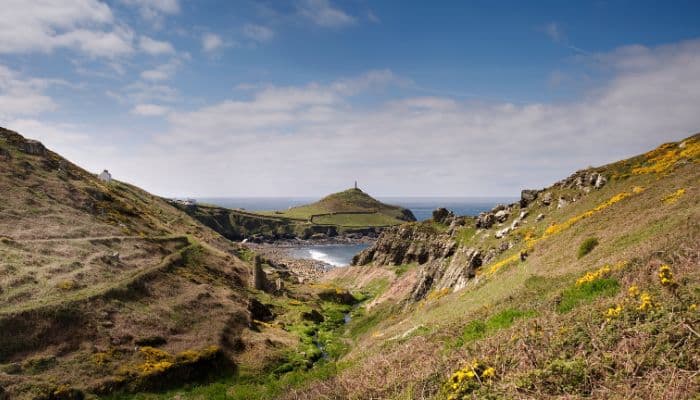8 Interesting Facts About Cape Cornwall
Cape Cornwall, or Kilgoodh in Cornish, which means ‘goose back’, is one of the two capes in Britain, the other being Cape Wrath in Scotland. Cape Cornwall creates an irregular headland formed of Mylor Slate, stretching 450 m from the cliff line at Priest’s Cove.
This tiny headland in West Cornwall, England, lies four miles or six kilometres north of Land’s End, close to the St Just town.
It is on the South West Coast Path leading to St Ives and Land’s End. After climbing up the Cape Headlands towards the mining stack, one encounters stunning panoramic views of the Atlantic Ocean.
Until 200 years ago and the coming of Ordnance Survey mapping in the 19th century, this small peninsula close to St. Just was considered the country’s most westernmost point.
Read along to explore more Cape Cornwall Facts!
1. Cornwall was created from part of France 400 million years ago
A new study has revealed that a large part of Cornwall and Devon were created millions of years ago when France collided with Britain.
Earlier, it was thought that England, Wales and Scotland were formed when the ancient landmasses of Laurentia and Avalonia converged more than 400 million years ago.

But recently, geologists from Plymouth University have discovered evidence in rocks of southwest England suggesting the region’s distinctiveness from the rest of the nation.
Underground volcanic eruptions in the area left deposits, which show that the Armorica landmass, which comprises present-day France, played a major role in creating Cornwall.
The findings show the presence of a clear geological border separating Cornwall and South Devon from the rest of the United Kingdom. This border runs from east to west, roughly from Exe estuary to the town of Camelford.
2. Fishing at Cape Cornwall is for the experienced
Cape Cornwall is an exposed rocky headland in the very west part of the UK. Here, large swells lash against it, and strong tides occur as water is forced up over the shallow ridge amidst Gribba Point and the Brisons.
Though launching is possible during calm seas, it is only suggested for experienced kayak fishermen and confident paddlers as the launch point is quite rocky. There is rough ground between the headland and the Brisons, but smoother ground predominates towards Gwenver and Sennen.
A car parking site is situated 100 metres uphill from the launch mark. One can expect to catch Bass, Pollack, and Wrasse. Anchoring may allow one to catch Bull Huss and Conger. Gurnards and Flatfish can be found in deeper water along with Mackerel and Garfish during the season.
Cornwall has always been famous for its Pilchards or Sardines, which have been pivotal to the survival of the Cornish people. The oldest and most well-recorded fishery here is the Pilchard Fishery. Although renamed as cornish sardines, these are the same fish, tasty and high in omega-3 oils.
3. The Brisons, two Rocks, lie about 1.6 km southwest of Cape Cornwall
The Brisons are two rocks lying 1.6 km southwest of Cape Cornwall. These offshore rocks are the starting point of the Cape Sports Event, which ends at Priest Cove.
These small landmasses in the Celtic Sea are 22 m and 27 m high. According to some people, they look like General Charles de Gaulle lying in his bath.

Many shipwrecks have been caused by Brisons Rocks. Once home to a prison, they are now a breeding ground for seabirds like gannets, fulmars or migrant birds like storm petrels.
They are linked to Gribba Point, close to Gunthen Gwidden Reef. The space in the reef is known as the Adgiwar gap.
An article published in a Cornish newspaper in 1878 referred to the reef between the Brissons and the land as Bridges. The reef had 3 gaps, the closest called Rose-an-pons.
4. A maritime chart dating to 1600 first mentioned the name ‘Cape Cornwall’
According to records, the headland was called ‘Cape Cornwall’ for the first time on a maritime chart around 1600. Its real Cornish name was Kilgoodh Ust, dating back to the 1500s, and was probably used by the natives.
Kilgoodh Ust, in English, means goose-back at St Just and refers to the shape of Cape Cornwall. It was called by different names later, all dropping the ‘Ust from its name. Another name was Pen Kernow.
5. Stone Burials called ‘cists’ have been found at Cape Cornwall
Cape Cornwall has been the site of archaeological surveys which revealed the presence of humans since the Late Bronze Age.
Additionally, box-structured stone burials called Cists filled with pottery have been found along with Ballowal Barrow on the nearby Carn Gloose cliffs, an ancient burial chamber.

The remains of medieval St Helen’s Oratory can be found on the landward part of the Cape. It is said to have been constructed over the site of a 6th-century church.
Also, a cliff castle close to the Cape indicates that it was an important region during the Iron Age.
6. Numerous harbours lie along the rugged Cornwall coastline
Cornwall’s beautiful and rugged coastline has housed fishing and trading communities for several years. The settlements of these groups have a rich history, and many have grown into small ports and harbours, which are important tourist destinations today.
Polperro is a harbour village with fishermen’s cottages, narrow streets and pubs. It has a museum offering insight into the region’s history, particularly the history of fishing and has a great collection of ship models. Visitors can explore the art galleries or go to Talland Bay.
Mevagissey harbour dates back to the 1700s. Named after Irish Saints, this place is known for its cafes, galleries and local shops, not to forget its scenic harbour wall.
Portscatho developed around the pilchard industry and gained popularity due to its protection from the prevailing winds. Here, fish were cleaned, packed and sent to Mediterranean ports. Today, the place is famous for recreational boating and tourism.
Penryn is one of the oldest towns of Cornwall and was once a prosperous seaport. It handled tin and copper in the 17th century and was called the Granite Port due to huge amounts of the stone leaving local quarries.
Porthleven is the southernmost port in Britain, and its harbour was constructed during the times of Napoleon. It is one of the liveliest places with artistic galleries, festivals and restaurants.
Newlyn is one of the biggest fishing ports in the UK, and Portreath was one of the earliest industrial ports of Cornwall.
7. An old tin mine on the cape is a famous World Heritage Site
Cape Cornwall Tin Mine remained operational between 1838 and 1883 and shut down. While its engine house was demolished, the chimney located close to the cape’s peak remained as an aid for ships. Later, somewhere in the 20th century, the floors and other areas were made into wineries and greenhouses.

In 1987, Heinz of the famous tomato ketchup and salad cream fame, bought this defunct mine and gave it to the nation. Today, it is part of the Cornwall and Devon Mining Landscape UNESCO World Heritage Site.
8. There’s much to do at Cape Cornwall
Cape Cornwall is known for its natural beauty and sites like the Priest Cove. It has a rocky beach with a tiny artificially made tidal pool, making it a safe place for children. The beach is dog-friendly, has a few huts and faces the Brisons.
The Cape Cornwall Golf Course is a natural course lying across cliffs and farmlands. On one side of the cape is a rocky cove called the Porthledden Cove, surrounded by cliffs lying near a valley home to a few unusual mine workings.
Conclusion
Cape Cornwall is truly a captivating place, steeped in maritime history and its age-old traditions. It is also famous for its mining heritage, and the iconic Cape Cornwall mine chimney stands tall as a testament to its glorious industrial past.
The cape is also known for fisheries and its biodiversity, adding to its charm and ecological importance in the region. Several port towns and harbours also lie along Cape Cornwall, each with its unique culture and way of life.
Cape Cornwall has yielded many ancient burials pointing to human settlement in the region since the last Bronze Age. Today, the Cape is visited by many for its historic buildings, monuments, breathtaking vistas and unparalleled natural beauty.
You might also like to read-
- 10 Major Straits Of Asia
- 10 Best Great Lakes Ship Tracker Tools
- 10 Gulf of Martaban Facts You Might Not Know
- 12 Gulf Of Mannar Facts You Might Not Know
- 10 Celtic Sea Facts You Should Know
- 9 Interesting West Philippine Sea Facts You Must Know
- 13 Gulf Of Riga Facts You Must Know
Disclaimer :
The information contained in this website is for general information purposes only. While we endeavour to keep the information up to date and correct, we make no representations or warranties of any kind, express or implied, about the completeness, accuracy, reliability, suitability or availability with respect to the website or the information, products, services, or related graphics contained on the website for any purpose. Any reliance you place on such information is therefore strictly at your own risk.
In no event will we be liable for any loss or damage including without limitation, indirect or consequential loss or damage, or any loss or damage whatsoever arising from loss of data or profits arising out of, or in connection with, the use of this website.
Do you have info to share with us ? Suggest a correction
Disclaimer :
The information contained in this website is for general information purposes only. While we endeavour to keep the information up to date and correct, we make no representations or warranties of any kind, express or implied, about the completeness, accuracy, reliability, suitability or availability with respect to the website or the information, products, services, or related graphics contained on the website for any purpose. Any reliance you place on such information is therefore strictly at your own risk.
In no event will we be liable for any loss or damage including without limitation, indirect or consequential loss or damage, or any loss or damage whatsoever arising from loss of data or profits arising out of, or in connection with, the use of this website.

About Author
Zahra is an alumna of Miranda House, University of Delhi. She is an avid writer, possessing immaculate research and editing skills. Author of several academic papers, she has also worked as a freelance writer, producing many technical, creative and marketing pieces. A true aesthete at heart, she loves books a little more than anything else.
Latest Maritime Knowledge Articles You Would Like:
Subscribe To Our Newsletters
By subscribing, you agree to our Privacy Policy and may receive occasional deal communications; you can unsubscribe anytime.















